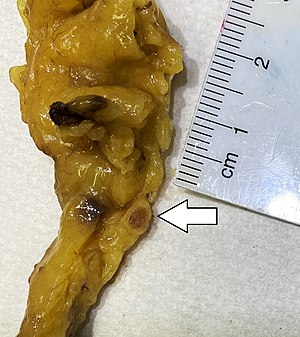Difference between revisions of "Lymph node grossing"
| Line 27: | Line 27: | ||
**For multiple lymph nodes in one block either 1 or 2: | **For multiple lymph nodes in one block either 1 or 2: | ||
**#Submit the lymph nodes without sectioning. | **#Submit the lymph nodes without sectioning. | ||
**#Ink the individual lymph nodes before sectioning - so | **#Ink the individual lymph nodes before sectioning - so the sections can be matched under the microscope. | ||
Notes: | Notes: | ||
Revision as of 19:09, 15 October 2023
Lymph node grossing is an important element of the lymph node assessment in cancer staging.
General
In many cancer types, the lymph node count is important to quantify, as it is used as a quality metric.
Cases with too few lymph nodes may be under-staged and thus under-treated.
Gross
Identification of lymph nodes
- Visual.
- Palpation - more important than visual.
Gross interpretation
Normal lymph node:
- Firm (relative to adipose tissue).
- Glistening surface when cut.
Pathologic lymph node:
- White lesions, especially irregular = suggestive of carcinoma.
- White, glistening, with lobulated surface - "fish flesh" = suggestive of lymphoma.
- Subtle lobulation (~1 mm) on section suggestive of follicular lymphoma.[1]
Submission
- The number of lymph nodes in each block should be noted in the gross report. †
- If multiple lymph nodes are present in the one block they should not be sectioned unless inked. ‡
- For multiple lymph nodes in one block either 1 or 2:
- Submit the lymph nodes without sectioning.
- Ink the individual lymph nodes before sectioning - so the sections can be matched under the microscope.
- For multiple lymph nodes in one block either 1 or 2:
Notes:
† It is useful to use the word "possible" when describing lymph nodes; in the gross report "possible lymph node" is preferred over "lymph node". Lymph nodes are not reliably identified at gross.
‡ If multiple lymph nodes are sectioned and these are not marked: it is not possible to reliably count the number of positive lymph nodes. Example: two lymph nodes are bisected and two sections have a small amount of cancer. Is that two positive lymph nodes or one positive lymph node that was bisected? Answer: It is not possible to tell.
See also
References
- ↑ Bailey, D. 5 August 2010.
